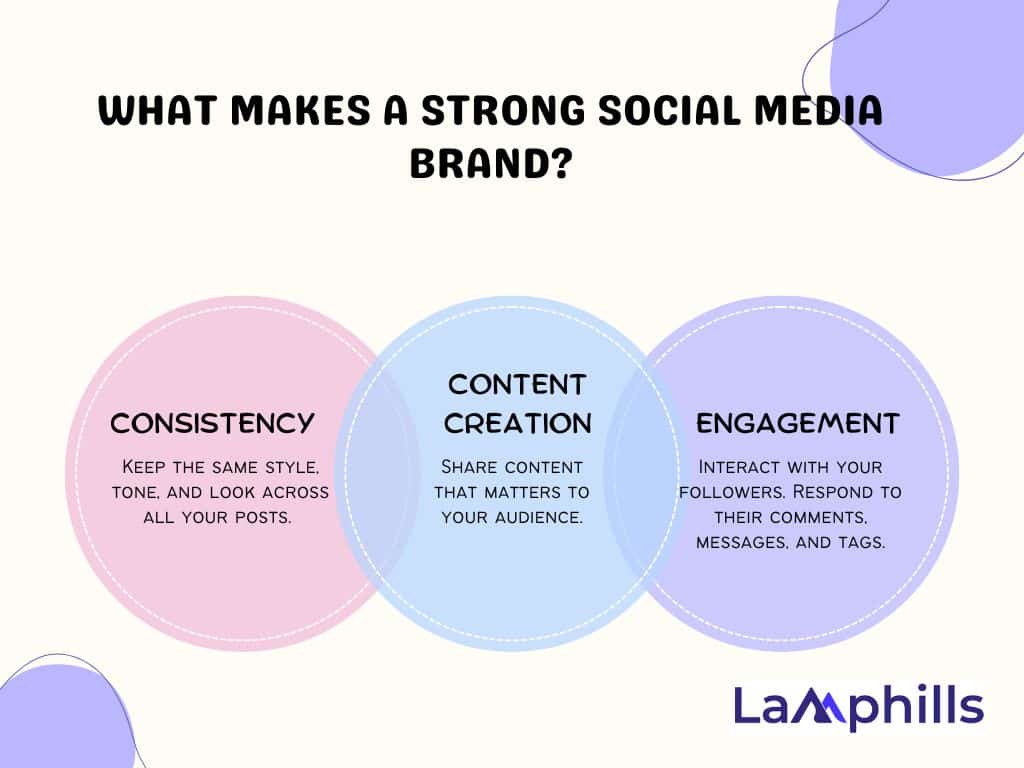Social media branding has become one of the most powerful ways to boost your brand’s visibility and impact. Reports have it, that as of April 2024, there were 5.18 billion people using the internet worldwide. And 4.89 billion of them were on social media! This number is expected to grow to almost six billion by 2027.
That’s an enormous audience your brand can reach on social media! Indeed, social media has changed how brands connect with their customers, making it the main way they interact.
With so many social media platforms out there, it can be tough for some companies to keep a consistent brand image across them all. Each platform requires different approaches, and they each have their own unique style and preferred types of content.
In this guide, we’ll explore why it’s essential to stay consistent on social media and offer tips for keeping a steady brand voice across multiple platforms. Keep reading!
Key Points
- Use the same colors and style on all platforms so people quickly spot your brand.
- Keeping a steady look and voice across social media makes your brand feel reliable and strong.
- Communicate clearly and concisely in all your posts, making your message easy to understand and engaging.
- Share content that fits your brand’s style and interests your followers to keep them engaged.
- Show followers you care by replying to their comments and messages, building a loyal community.
What Is Social Media Branding?
With unlimited internet access, and everyone always scrolling on social media, building a clear brand identity is essential. When I first began working on my brand’s social media, I knew it was important to be noticed, but I didn’t realize how crucial it was to be memorable. Keeping my branding consistent was the key that helped people recognize my brand among all the online noise.
Social media branding is about creating and maintaining a clear, consistent image of your brand while connecting with your audience on different social platforms. Simply put, it’s how you present your brand to the world on social media.
It’s more than just logos and colors; it’s about creating a cohesive story that tells people who you are, what you stand for, and why they should trust you. Every post, comment, and message should align with your brand’s values and voice.
Why Is Branding So Important for Business Success?
Your brand identity represents your values, personality, and ideas. It’s the “face” of your business—the way customers see and understand your brand.
A strong brand identity doesn’t just support your brand; it helps it grow. It instantly tells your customers who you are and why they should care about what you offer.
To build and keep this identity strong, you need to share stories that your customers can relate to. This storytelling is what branding is really about.
The more interesting and genuine your story is, the more your audience will connect with it, helping your brand succeed.
What makes a strong Social Media Brand?

Building a strong social media brand means creating a lasting connection with your audience. To do this, there are a few key elements to focus on. Each of these helps your brand stand out, build trust, and keep people interested. Here’s what to keep in mind:
- Consistency: Keep the same style, tone, and look across all your posts. This helps people recognize and trust your brand.
- Content creation: Share content that matters to your audience. This includes photos and videos that match your brand’s message and connect with people.
- Engagement: Interact with your followers. Respond to their comments, messages, and tags to build relationships and long-term loyalty.
- Brand voice: Develop a unique, genuine brand voice that shows your brand’s personality and values.
- Community building: Encourage a sense of community. Use user-generated content (UGC) and create ways for followers to get involved and support your brand.
As you can see, consistency is the foundation that ties all these elements together. By staying true to your brand’s voice, style, and message, you create a recognizable and trustworthy presence.
And Why Does Consistency Matter?

Consistency in branding is like having a recognizable signature. It helps your audience remember and connect with your brand. Think about your favorite brands, whether it’s the fonts, the colors, or the tone, they all have something distinct and uniform that makes them stand out.
I noticed that when my brand appeared disjointed across platforms, it confused my audience. They weren’t sure what to expect from me, and that led to lower engagement.
Consistent branding can help improve your image, spark positive conversations about your brand, and build a stronger connection with your audience. These are all important factors that influence customers’ buying choices.
Here are some clear benefits of keeping your brand consistent:
- It shows professionalism, letting people know you care about your business, how it looks, and your customers.
- It helps people remember your brand. Over time, they get to know your brand through different online channels.
- It strengthens your brand’s personality. When people can connect with that personality, they’re more likely to become loyal customers.
In summary, being consistent builds trust. People want to follow brands they feel they know well. When your branding is the same everywhere, from Twitter to LinkedIn, you create a sense of reliability that keeps your audience coming back.
Top Tips for Consistent Branding Across Social Media
Building a consistent brand on social media helps people recognize and trust your business. It’s all about making sure your posts look, sound, and feel the same across all platforms.
As you know, each platform requires different approaches, and they each have their own unique style and preferred types of content. For example, Facebook, LinkedIn, and Google+ work well for sharing longer posts, while Twitter is better for quick updates. Meanwhile, platforms like Tumblr, Pinterest, Vine, and Flickr are ideal for sharing images and visual content, and so on.
Here are some simple tips to keep your branding strong and steady on social media. Whether you’re an experienced brand manager or a business owner juggling different tasks, these tips can help you create a unified brand that connects with your audience across platforms.
#1. Keep Your Brand Look Consistent
Having a uniform look across all your social media platforms helps people recognize your brand more easily. Why is that important?
When people know your brand, they’re more likely to buy from you and stay loyal. That’s why it’s essential to stick to specific colors and other visual elements. These help your customers spot your brand at a glance.
Imagine if your logo didn’t match the style of your social media posts, or if the posts themselves didn’t have a unified look. Would that make your brand seem appealing? Probably not.
To build a strong brand on social media, keep your colors and fonts consistent. This helps make your brand memorable.
For example, Starbucks’ green-and-white mermaid logo is easy to recognize from far away. They use the same logo and matching cover photos on their social media profiles, making it simple for people to spot their brand instantly.
#2. Clear Brand Voice and Tone
Do you find yourself using certain phrases or words often on social media? This might mean you’re developing your brand voice. Your brand voice shows through the words and images you use. Whether it’s formal, informative, or playful, it reflects your brand’s personality. Your tone, on the other hand, affects how your customers feel when they engage with your brand.
For example, if you’re friendly on Facebook but sarcastic on Twitter, it can confuse your audience. Look at McDonald’s. They keep their brand voice fun across all their social channels. They use casual terms like ‘LOL’ and ‘BTW’ to sound friendly and conversational. They’ve even added Grimace to their profile picture to show off their brand personality.
#3. Clear and Simple Messaging
Talking to your audience is a big part of your social media brand. This includes captions, comments, and DMs. No matter how you’re communicating, your message should always be easy to understand.
Take Pringles’ tweet, for example. It’s a fun, short message that appeals to both parents and kids for Halloween.
This shows how to keep your social media posts short and clear. After reading it, parents might even think about giving out Pringles instead of candy for trick-or-treating!”
#4. Creating Content That Connects
Your social media branding strategy includes the content you share. It’s important that your content follows your brand’s style and speaks to your audience.
Think of an energy drink brand like Red Bull. What do you imagine? Probably adventure, right? To match their audience’s love for excitement, Red Bull posts action-filled, eye-catching content on Instagram.
Their whole Instagram page shows off thrilling sports and adventures, making it clear what Red Bull stands for energy.
#5. Active Community
Posting regularly on social media is just the beginning. To build a strong brand, you need to listen to your audience and join their conversations.
Are they asking for a specific kind of post or showing interest in a certain product? Share similar content on all your social channels. Did someone leave a negative review? Apologize and see if you can turn their experience around.
When people feel heard, you start creating a loyal community around your brand.
#6. Choosing the Right Platforms
Are you managing Twitter, Instagram, Facebook, LinkedIn, TikTok, Snapchat, YouTube, and others all at once? If so, you might start feeling overwhelmed pretty quickly.
While social media branding might look easy at first, it actually takes a lot of time and effort. To prevent burnout, it’s essential to pick the right platforms for your brand. But how can you decide which ones?
Start by understanding where your audience spends most of their time. For example, are they more active on LinkedIn, TikTok, Facebook, or somewhere else? If you’re in the food industry, LinkedIn may not be the best choice.
Then, think about your brand’s goals. Are you trying to build awareness, get new customers, or drive traffic to your website? Choose platforms that align with these goals.
Lastly, watch what your competitors are doing on social media – which platforms they’re using, the kind of content they post, and how well they’re doing. If they’re succeeding on a platform, you wouldn’t want to miss out on the same opportunity, would you?
#7. Optimized Profiles
Optimizing your social media profiles helps make a great first impression. It’s an important step to build your brand’s trust and increase engagement. Here’s how to optimize your profiles:
- Upload a clear profile picture (like your logo or a photo that shows your brand’s personality).
- Use a cover photo that matches your profile picture on platforms like Facebook, LinkedIn, and Twitter.
- Write an engaging bio that gives a hint of your brand’s style and voice.
- Add a link to your website or product page.
- If you have a physical location, include the address.
- Showcase your latest products.
For example, look at Nike’s Instagram profile. They have their famous swoosh logo as their profile picture, their bio lists the address of their headquarters, and there’s a link to their website. They also have a one-line bio that tells you they’re all about running shoes. Plus, they’ve set up an Instagram Shop that visitors can access with the ‘View Shop’ button.
#8. Using Social Media Tools Effectively
Most social platforms have built-in tools to help you improve your brand’s social media presence. For example, TikTok lets you schedule posts between 15 minutes and 10 days ahead, while Instagram allows scheduling up to 75 days in advance.
Scheduling posts:
Using these scheduling tools helps you keep a steady plan for posting, especially if you manage multiple social media accounts. With this approach, you can create and schedule content in advance, so it’s ready to go on the planned date—even if you get busy or forget.
You can also use social media analytics tools to learn more about your audience and increase engagement. For instance, Meta Business Suite gives detailed insights about your content and audience on Facebook and Instagram, and LinkedIn Analytics does the same for posts and pages.
So, how does analytics help with engagement? Let’s explore that further.
#9. Monitor and Adjust Your Branding Regularly
Even if you don’t post a lot on social media, it’s important to keep track of how your brand is doing. This will help you see if your plans need any adjustments. For instance, if your usual style of messaging isn’t connecting well with your audience and isn’t helping you reach more people, it might be time to try something different.
Take a look at the audience insights from Meta Business Suite for one brand’s page.
It shows that most of the audience is between 18 and 34 years old. Content aimed at people in their 60s probably wouldn’t work well here. So, paying attention to your audience and regularly checking your social media performance can show you if they’re connecting with your brand.
Also, your audience might get bored of seeing the same type of content. Try adding some fresh faces to keep things interesting!”
#10. Collaborations and Partnerships
Did you know that collaborations on social media helped Daniel Wellington become a popular watch brand? Their success story started with Instagram.
In 2011, Daniel Wellington began partnering with Instagram influencers who had around 5,000 followers. They sent these influencers a watch as a gift, and in return, the influencers shared a post featuring the brand’s product.
As the brand grew, more and more people started posting their own photos with Daniel Wellington watches. Today, the brand still encourages customers to share their photos with the hashtag #danielwellington.
To make your social media branding effective, think about collaborating with influencers and popular personalities.
Here are some questions to help you pick the right partners:
- What topic or interest does the influencer focus on?
- What’s your budget?
- What’s their personality like?
For example, Samsung Canada worked with a travel photographer on Instagram to showcase their phone protection gear. It was a well-matched partnership that promoted their product effectively.
To make your brand stand out on social media, keeping a steady, consistent style across platforms can build trust and make your brand memorable. Here’s a Social Media Branding Guide Template that gives you the basics you need to define your brand’s look, voice, and style, so everything feels the same, no matter where people find you.
Use this template to stay organized and make sure every post shows off your brand in the best way possible!
Best Practices to Improve Your Social Media Branding
To make your brand stand out on social media, it’s important to follow some simple, effective practices. These tips will help you create a consistent and engaging online presence that attracts and keeps your audience’s attention.
#1. Make a Social Media Branding Guide
Consistency is key to a strong brand. A social media style guide helps keep everything on track by setting rules for how you present yourself online.
This guide should cover things like your brand’s voice, tone, and look (including logo, colors, and fonts). It acts as a reference for your team to ensure everyone knows how to represent the brand on social media.
Here’s what to include in your brand style guide:
- All social platforms you use
- All social media accounts (helps keep brand names consistent)
- Brand voice and tone: For example, how many emojis to use, whether posts will be formal or casual, and if GIFs or stickers are allowed.
- Logo: Make sure the same logo is used across channels. Note if it changes for events like Pride Month.
- Fonts and colors: Include specific colors and where to use them.
- Images: Mention if you’ll use stock photos, user-generated content, or your own photos.
- Post frequency: How often you’ll post.
- Hashtags: List a specific strategy for campaign-related and branded hashtags.
- Audience details: Define your target audience by age, interests, challenges, and what content they engage with.
#2. Practice Social Listening
Social listening means keeping an eye on what people are saying about your brand, industry trends, and customer feedback. By analyzing this, you can find new ways to connect with your audience.
Here’s how to make the most of social listening:
- Track important topics and keywords for your brand to see what people are talking about most.
- Monitor mentions of your brand and products.
- Look for customer pain points to see where you can improve.
- Notice if customers mention ways they’d like their issues solved—it’s great feedback.
- Respond quickly to both positive and negative feedback to show you care about customer experiences.
#3. Make a Content Calendar
A social media content calendar helps you plan and organize your posts ahead of time. It gives you an overview of what content will go live on each platform in the coming days or weeks.
When creating a calendar, consider including these details for each post:
- The date and time it will be published
- The topic (e.g., educational, product-focused, or event-related)
- The format (like a video, story, or regular post)
- The text (copy) for the post
- Any images, videos, or links you’ll include
- Who’s responsible for creating it, if there’s a team involved
- The platform (like Instagram, Twitter, etc.)
- Which account it’s going on, if you have multiple accounts on a platform
- The hashtags you’ll use
- The status (whether it’s scheduled, live, or in progress)
- A link to the live post once it’s published
Having a calendar like this helps you stay on top of deadlines, keep a steady posting schedule, and plan content for special events and holidays. It also helps you balance different types of content.
For example, a content calendar for Wendy’s in June 2023 could reveal that they posted mostly on Facebook with a focus on image content, showing what’s working best for them.
#4. Use Content from Your Audience (User-Generated Content, or UGC)
User-generated content (UGC) is any content created by your customers about your brand. It’s powerful because it’s authentic and more trustworthy since it comes directly from real people.
UGC also encourages customers to be part of your brand’s journey and builds trust with your audience. Here’s how you can encourage UGC:
- Run a contest where people create content with your brand’s hashtag.
- Create a branded hashtag and remind followers to use it.
- When reposting customers’ content, tag or mention them in your post to make them feel valued.
- Organize giveaways and ask people to share UGC to enter.
- Offer a discount for the best UGC post about your brand.
For example, Apple uses #ShotoniPhone to encourage iPhone users to share their photos.
#5. Test, Analyze, and Adjust
To see if your social media strategies are working, check the performance of your content on different channels.
Metrics help you understand how people respond to your brand and improve your strategy. Focus on the following metrics:
- Impressions: The number of times your post shows up in people’s feeds.
- Reach: How many people see your post. A high reach among non-followers suggests your post is popular and being shared.
- Engagement Rate: Measures interactions like likes, comments, and shares compared to your follower count.
- Click-Through Rate (CTR): Shows how often people click on your post to learn more (like visiting a website). A high CTR means your post or ad is engaging.
Remember, these metrics work best when you look at them together. For instance, a high impression count but low engagement might mean the content isn’t interesting enough to engage viewers.
Use these insights to make your future posts even better.
Bottom Line
Posting on social media is a great way to grow your brand and reach more people online. But with so many brands on social media, its more challenging, than ever.
The secret is to see social media not just as a branding tool, but as a way to truly connect with your audience. Make your brand feel human to keep people interested, and stay consistent across all platforms.
It may take some time, but with patience and small steps, you’ll soon build a strong and memorable brand on social media.
Frequently Asked Questions.
What is branding on social media?
Social media branding is a way for businesses to share content on social media to boost brand awareness and connect with their audience.
How do you introduce a brand on social media?
Simple Steps
1. Tell Your Brand Story
2. Pick the Best Platforms
3. Use Eye-Catching Images
4. Write a Catchy Launch Post
5. Connect with Your Audience
6. Partner with Influencers or Brands”
How do you create social media branding?
1. Define Your Brand – Decide on your brand’s look, feel, and message.
2. Know Your Audience – Understand who you’re talking to and what they like.
3. Plan Your Content – Choose the types of posts and topics that match your brand.
4. Try Paid Ads – Use paid ads to reach more people.
5. Track and Improve – Review your posts and make changes to get better results.
6. Be Consistent – Keep your style and message the same on every social platform.
7. Add Branding to Every Post – Make sure every post reflects your brand style.
What is the first step for social media branding?
Create content that fits your brand and is interesting to your target audience. Follow these steps to build a strong social media content plan: Set clear goals. Decide what you want to achieve with your social media and choose key ways to measure success (KPIs).
How do you manage your brand on social media?
Simple steps:
1. Start with the basics.
2. Expand your visual branding.
3. Define your target audience.
4. Set a clear brand voice and tone.
5. Use separate accounts for different focus areas.”
Similar Article
The Ultimate Guide to Social Media Branding: Tips for Creating Your Online Identity
Media Mix Modeling Explained: The Key to Effective Marketing Investment
What Is Social Media Reach? + How to Measure It in 2024






